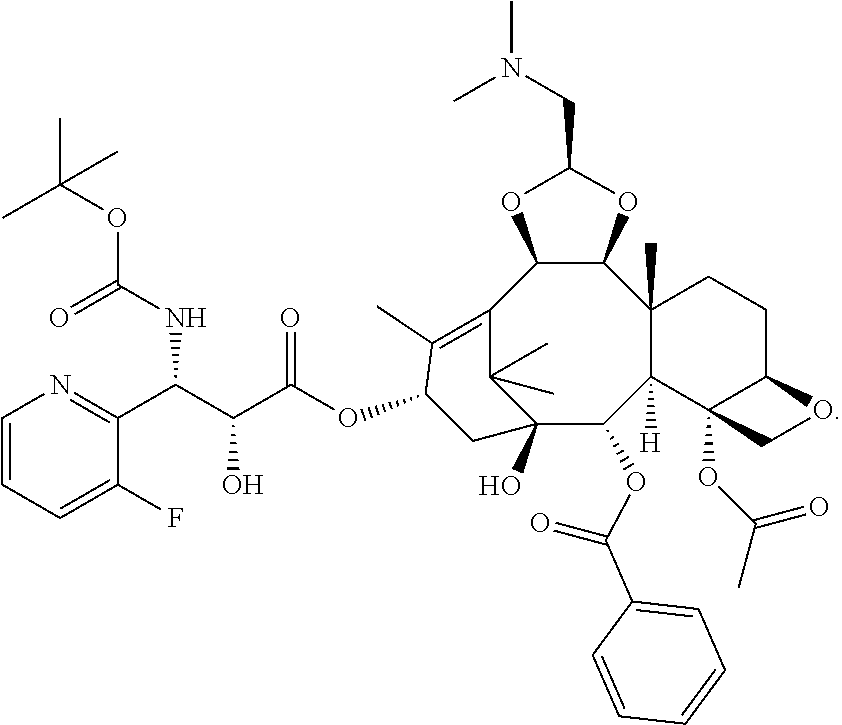Methods of treating CNS tumors with tesetaxel
a technology of cns tumors and tesetaxel, which is applied in the field of methods of treating cns tumors with tesetaxel, can solve the problems of poor prognosis of locally advanced or metastatic breast cancer (la/mbc) and the occurrence of cns metastases in patients with cancer, and achieves high oral bioavailability and high solubility
- Summary
- Abstract
- Description
- Claims
- Application Information
AI Technical Summary
Benefits of technology
Problems solved by technology
Method used
Image
Examples
example 1
[0088]Patients with HER2 negative, HR positive LA / MBC previously treated with a taxane in the neoadjuvant or adjuvant setting are recruited and randomized into one of two treatment arms. Known metastases to the CNS are permitted but not required. An additional analysis of CNS tumor efficacy will be conducted for patients with CNS tumor metastases.
[0089]Patients in arm 1 are treated orally with 27 mg / m2 of tesetaxel on Day 1 of a 21-day cycle and 14 daily dosages of 1,650 mg / m2 of capecitabine (825 mg / m2 at twice-daily intervals) starting on Day 1 and ending on Day 15 of a 21-day cycle, beginning with the evening dose on Day 1 and ending with the morning dose on Day 15 of each 21-day cycle. Treatment continues in 21-day cycles until the disease progresses or unacceptable toxicity is observed in the patient.
[0090]Patients in arm 2 are treated with 14 daily dosages of 2,500 mg / m2 of capecitabine (1,250 mg / m2 at twice-daily intervals) starting on Day 1 and ending on Day 15...
example 2
[0092]Elderly patients (age≥65) with HER2 negative LA / MBC not previously treated with chemotherapy for LA / MBC are recruited into one treatment arm without randomization. Inclusion criteria include prior endocrine therapy with or without a CDK 4 / 6 inhibitor unless endocrine therapy is not indicated. Known CNS metastases are permitted but not required.
[0093]Patients are treated with 27 mg / m2 of tesetaxel monotherapy orally once on Day 1 of each 21-day cycle. Treatment continues in 21-day cycles until documentation of progressive disease (PD), unacceptable toxicity observed in the patient or other decision(s) to discontinue treatment.
[0094]The primary endpoint of the study is objective response rate as assessed by the investigators using RECIST 1.1 criteria. Secondary endpoints include progression-free survival as assessed by the investigators using RECIST 1.1 criteria and overall survival. Efficacy for CNS metastases is measured by the CNS objective response rate and CNS...
example 3
[0095]Adult patients (age ≥18) with triple negative LA / MBC who have not received prior chemotherapy for LA or metastatic disease are recruited and randomized into three treatment arms. The patients' most recent biopsy must be HR negative. Known metastases to the CNS are permitted but not required.
[0096]Patients are treated with 27 mg / m2 of tesetaxel orally on Day 1 of each 21-day cycle, plus one of the following: (Al) nivolumab (360 mg) by 30-minute intravenous infusion on Day 1 of each 21-day cycle; (A2) pembrolizumab (200 mg) by 30-minute intravenous infusion on Day 1 of each 21-day cycle; or (A3) atezolizumab (1,200 mg) by 60-minute intravenous infusion (if first infusion is tolerated, all subsequent infusions may be delivered over 30 minutes) on Day 1 of each 21-day cycle. Treatment continues in 21-day cycles until documentation of progressive disease, unacceptable toxicity observed in the patient, or other decision(s) to discontinue treatment.
[0097]The primary end...
PUM
| Property | Measurement | Unit |
|---|---|---|
| Length | aaaaa | aaaaa |
| Toxicity | aaaaa | aaaaa |
Abstract
Description
Claims
Application Information
 Login to View More
Login to View More - R&D
- Intellectual Property
- Life Sciences
- Materials
- Tech Scout
- Unparalleled Data Quality
- Higher Quality Content
- 60% Fewer Hallucinations
Browse by: Latest US Patents, China's latest patents, Technical Efficacy Thesaurus, Application Domain, Technology Topic, Popular Technical Reports.
© 2025 PatSnap. All rights reserved.Legal|Privacy policy|Modern Slavery Act Transparency Statement|Sitemap|About US| Contact US: help@patsnap.com


